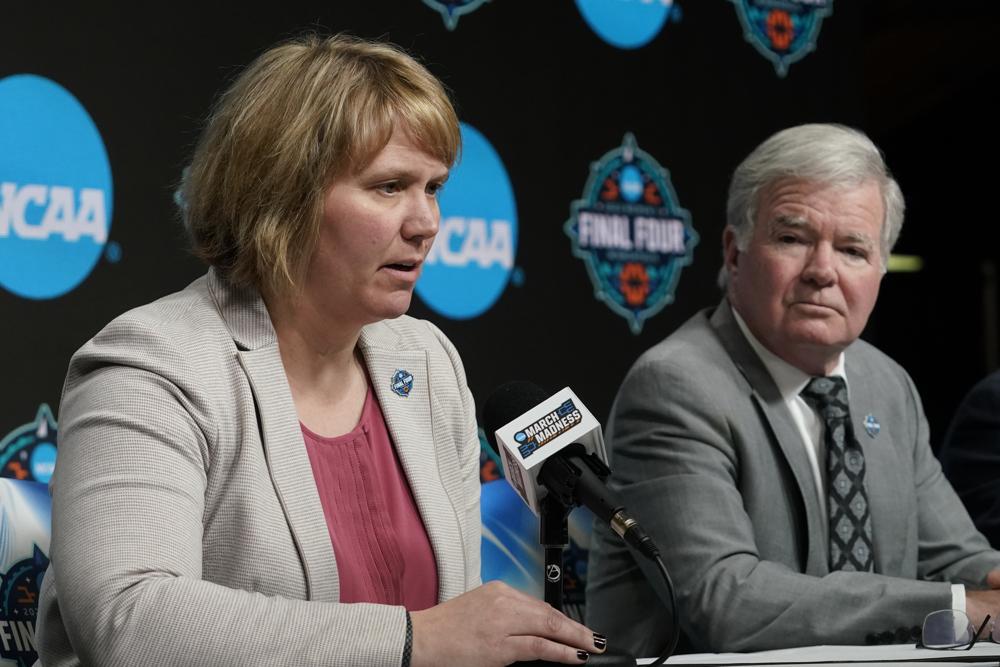
MINNEAPOLIS (AP) — A year after glaring inequities were revealed at the women’s NCAA Tournament and less than two weeks after sharp criticism from Congress, NCAA President Mark Emmert declared Wednesday that he was happy with the institution’s progress but said there had only been “preliminary discussions” about distributing tournament revenues to women’s programs.
Emmert said the work ahead improving conditions for women’s basketball includes negotiating a new television contract for the women’s tournament and potentially having a similar revenue distribution protocol as the men’s event.
Emmert was careful not to call for specific changes ahead of discussions by the NCAA’s hundreds of member schools, and he declined to offer his own viewpoint.
“It’s up to the schools and what they want to do in that regard,” he said at the site of the women’s Final Four in Minneapolis. “It’s a complicated relationship because the championships on the men’s side, the relative weight of moving forward in the tournament has been diminished over time. Those in the membership who think there shouldn’t be that much emphasis on winning in the tournament.”
Sending money to the women’s programs is something coaches have been clamoring for. Men’s conferences receive hundreds of thousands of dollars per tournament game involving one of their teams, money they then redistribute to schools. There’s no such system on the women’s side.
Emmert said adopting such a payment structure won’t be a quick fix and will require approval from several NCAA committees.
“There’s really only just preliminary discussions about it,” he said. “I would hope those are decisions that can be made within the next calendar year, for example. If by this time next year there’s some notion of a direction to go in, that would be great.”
Emmert said that wouldn’t mean it could be implemented immediately.
“There’s no reason why they couldn’t start that debate and that discussion,” he said. “But it is a very challenging debate among the schools. Once you start talking about how you’re going to divide resources, then those are difficult.”
It’s easier to pay the men thanks to the NCAA’s deal with CBS and Turner. The original contract averaged $770 million per year with an extension in 2016 jumping that per-year average to $1.1 billion in 2025.
The women’s tournament currently is bundled with other women’s championships for TV rights. The current contract with ESPN is up in 2024. ESPN is giving each game in this tournament its own window on one of its channels, with four games on ABC for a second straight year.
“It’s obviously in everyone in college sports’ best interests to maximize a revenue that you can produce from media contracts, while recognizing you want to balance that with making sure you get the right coverage, too,” Emmert said. “So it’s not just about money, of course.”
A law firm hired to review gender equity issues at NCAA championship events outlined differences between the men’s and women’s events in a blistering report last summer. That came after 2021 social media posts, most notably that of Oregon forward Sedona Prince, exposed some of the glaring inequities.
Three congressional lawmakers sent a letter to Emmert this month accusing the organization of making “inadequate progress” in addressing “historically disparate” treatment of male and female athletes.
Emmert and NCAA Vice President for women’s basketball Lynn Holzman pointed to positive changes this year that included using the phrase “March Madness” for the women’s tournament and expanding the field to 68 teams to equal the men.
“The attendance for the rounds leading up to the women’s Final Four, we have set records with those,” Holzman said. “The ratings by our ESPN broadcast partner also have set records, but all of that is a testament to women’s basketball, the leadership that occurs on campus with our coaches, the administration, and most importantly, our student-athletes.”
Both Emmert and Holzman said many of the changes adapted this year were more behind-the-scenes pieces centered around branding and things that were meaningful to the student-athletes.
“Many of the efforts are not particularly visible, and indeed they are not aimed necessarily even at this particular year,” he said. “But in making sure we have a sustainable and embedded model that provides the kind of continuity of these championships moving forward.”
TOP PHOTO: NCAA president Mark Emmert isstens as Vice President for Women’s Basketball at NCAA Lynn Holzman speaks at a news conference at the Target Center, site of of the Women’s Final Four NCAA tournament Wednesday, March 30, 2022, in Minneapoils. (AP Photo/Eric Gay)
More AP coverage of March Madness: https://apnews.com/hub/march-madness and https://apnews.com/hub/womens-college-basketball and https://twitter.com/AP_Top25










